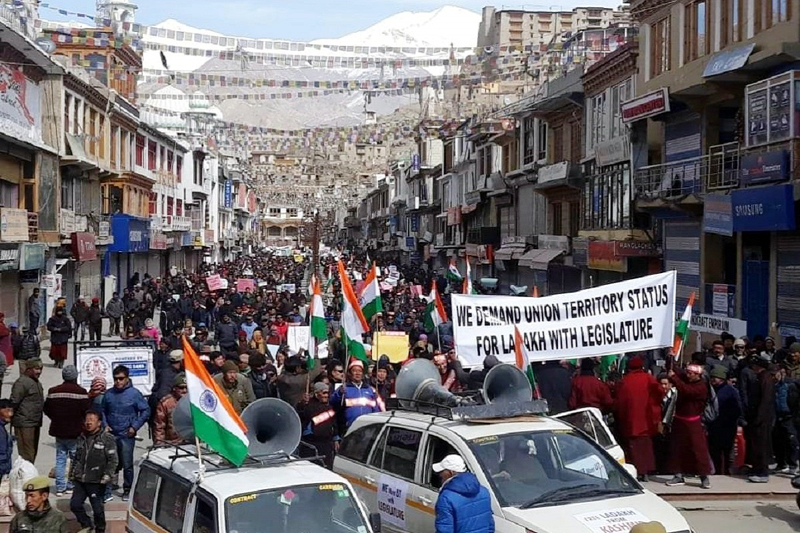Sonam Dorjey
Ladakh province of erstwhile state of Jammu and Kashmir came into much prominence after abrogation of Article 370 of Indian Constitution and carving out of Union territory of Ladakh. This development was not to the liking of China and Pakistan – the two enemy neighbours of India. Even in Ladakh region – the two districts Leh and Kargil had different opinions on this development. While people of Leh celebrated it with much fanfare, the people of Kargil protested against it.
However, after hectic parlays and persuasions things began to settle gradually, though, some underlying concerns remained in Kargil. The two organizations – LBA from Leh, and KDA from Kargil came to centre stage to raise the issues of the two districts. Though initially opposed to each other, they made a common cause on the issue of Statehood for Ladakh – a development which took everybody by surprise and shock.
Thupstan Chhewang, the most popular yet inscrutable leader of Ladakh is currently treading on a path that is raising eye brows within the Buddhists of Ladakh, especially after his alleged “unilateral decision” to align with Kargil Democratic Alliance on the Statehood issue. August 1 (2021) saw the unthinkable alliance of Kargil leaders under the aegis of KDA and those of Leh under LBA which prominently comprised veteran leaders like Thupstan Chhewang (formerly affiliated to BJP), Asgar Ali Karbalai (Vice President of Territorial Congress Committee) and Qamar Ali Akhon (of National Conference). Many termed it as a historic event of two regions with constrasting political aspiration and arch rivalry coming together for the larger cause of protecting Ladakh’s interest while some termed it as a marriage of convenience to arrest the growing influence of BJP in Ladakh. The antagonistic views that respective leaders harbour for each other is evident from the press statement (September 28, 2020) made by Thupstan Chhewang calling the leaders of KDA as akin to the “Tukde Tukde Gang” and Anti National. On the other hand, AA Karbalai always derided Thupstan Chhewang and his associates for celebrating the UT status for Ladakh.
This “marriage of convenience” appears to be taking its toll on the Buddhist unity in Ladakh with cascading effect and regional units like that of Nubra distancing itself from Thupstan Chhewang-led LBA on the issue of Statehood. A similar reaction also emanated from Kargil when 11 primary members of the regional unit too resigned in protect against its President’s decision to join KDA for talks on Statehood demand with LBA. Close on the heels of this, a meeting between Thupstan Chhewang and the dissident LBA Nubra on November 17 also failed with the latter remaining firm on its earlier stand to opposite the Statehood demand.
The issue of constitutional safeguard which was initially raised by the student community of Leh on December 12, 2019 was soon taken over by the veteran leaders of Leh who on August 29, 2020 announced the formation of a so called apolitical platform later to be named as Apex Body on Peoples’ movement on 6th Schedule on September 15, 2020. The Apex Body in no time managed to garner support of the Buddhist masses of Ladakh cutting across political lines. On the other side, origin of KDA dates back to October 16, 2020, when leaders of Kargil irrespective of political and religious affiliation (except Buddhists) formed KDA, essentially to highlight two-point agenda viz strongly oppose abrogation Article 370, 35-A and demand restoration of pre-August 05, 2019 position of erstwhile J&K State.
So what brought these two ideologically opposite groups together and execute their ‘marriage of convenience’ is forcing political pundits to contemplate on a conspiracy theory hatched somewhere and aptly using the growing angst and personal demeanor of leaders like Thupstan Chhewang.
Moreover, what is also disturbing the Ladakhi people and the countrymen is the shifting of goal posts by the LBA leaders. The people particularly in Kashmir Valley and Jammu region had lauded the Leh leadership for their negotiating skills, and unified approach for seeking Union Territory for Ladakh – a neglected province in erstwhile state of Jammu and Kashmir. Cutting across political and religious affiliations the people of the region had in one voice demanded UT status. Feeling no dichotomy in these affiliations, the Union Government had no objection to meet their genuine demand which was ultimately granted after abrogation of Article 370, and article 35-A, and carving out two UT’s- Union Territory of Ladakh, Union Territory of Jammu and Kashmir.
The grant of UT status was termed as a landmark decision by the people of Leh who celebrated it as freedom from neglect and discrimination.
A new dawn of empowerment, self rule, development and prosperity ushered in. Though birth pangs exists there, things are to settle yet, and may take some time more to take a final shape. There are no doubt some important concerns like rising unemployment, protection of land and cultural rights etc. among the people which need to be redressed at the earliest so that any apprehension vis a vis their dilution or negligence may be over. The Government of India need to redress these grievances by taking people of this religion into confidence, and by not delaying talks. The delay dallying tactics adopted by the Union Government may only fuel suspension among the people on the intentions of the Government. The shifting of goal posts from Union Territory to Statehood has wider ramifications nationally, internationally and at UT level, particularly at a time when China is hell bent on disturbing the status quo, and the armies of two countries are face to face at LAC.
Besides, these shifting of demands may develop distrust among the Union Government and the concerned parties not only from Ladakh region, but also from other states who may have to enter into talks. This distrust may not be a healthy development for the country.


